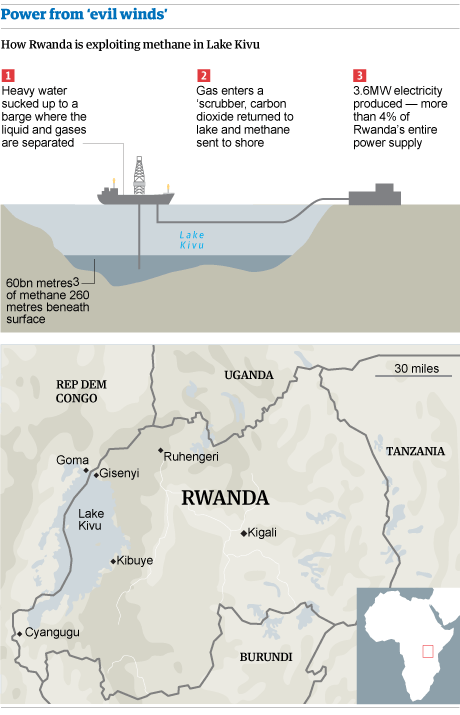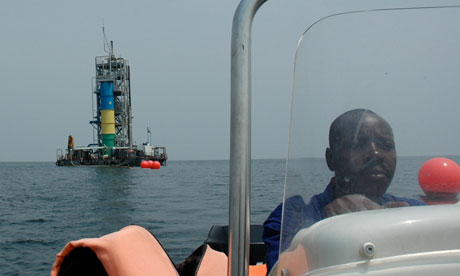It's dusk on Lake Kivu and the fishermen sing while paddling out in their catamarans, three canoes secured together with long wooden poles. As the twin volcanoes on the far shore disappear into the darkness the men spark kerosene lamps to attract the sambaza sardines into their nets. Across the vast lake their lanterns offer the only tiny sequins of light.
At least that is how it used to be. Now, near the northern shore, the bright fluorescent bulbs illuminating a tall barge can be seen from miles away. It is the start of a project that could light up the whole of Rwanda for decades, while also reducing the risk of disaster for the two million people living alongside this rare "exploding lake".
In a world first, the barge is extracting gases that are trapped deep in Lake Kivu's waters like the fizz in a champagne bottle. Methane, the main constituent of natural gas used for household cooking and heating, is then separated out and piped back to the rugged shore where it fires three large generators.
The state-owned Kibuye Power plant is already producing 3.6MW of electricity, more than 4% of the country's entire supply. But the success of the pilot project, and the huge unmet demand for power in Rwanda — only one in 14 homes have access to electricity — has encouraged local and foreign investors to commit hundreds of millions of dollars to new methane plants along the lakeshore.
Within two years, the government hopes to be getting a third of its power from Lake Kivu, and eventually aims to produce so much energy from methane to be able to export it to neighbouring countries.
"Our grandfathers knew there was gas in this lake but now have we proved that it can be exploited," said Alexis Kabuto, the Rwandan engineer who runs the $20m Kibuye project. "It's a cheap, clean resource that could last us 100 years."
Historically, Lake Kivu's gas has been a killer. Deaths attributed to invisible pockets of carbon dioxide rising from vents along the shoreline, known as mazukus, or "evil winds", are frequently reported, especially on the Congo side. But it is the gas dissolved in the water that may present a far greater threat.
Some scientists say that the ever-expanding volumes of carbon dioxide and methane in Lake Kivu, coupled with the nearby volcanic activity, make a limnic eruption (also referred to as a lake overturn, in which CO2 suddenly erupts from the lake) highly likely at some stage in the future unless degassing occurs. This has now begun with the extraction of some of the 60bn cubic metres of methane in the water.
The world's only two other known "exploding lakes", Monoun and Nyos, both in Cameroon, overturned in the 1980s. The clouds of carbon dioxide that burst through from the deep water left about 1,800 people dead from asphyxiation. But Lake Kivu is nearly 2,000 times larger than Lake Nyos, and is in a far more densely populated area. Cindy Ebinger, a professor of earth sciences at the University of Rochester in the US, who co-authored a study earlier this year that described Kivu as possibly "one of the most dangerous lakes in the world", said: "You don't even want to think about the scale of the devastation that could occur."
The lake's potential to both enhance and destroy lives stems from its geography. Nestled on the border between Rwanda and Democratic Republic of Congo, it sits at the highest point of the western arm of the Great Rift Valley. On the Congolese side, Mount Nyiragongo and Mount Nyamulagira have erupted in recent years, the former sending scalding tongues of lava into the lake in 2002. The seismic activity around the lake is responsible for the steady injection of volcanic gas into the water, where it settles in a dense saline layer more than 260 metres beneath the surface.
To harvest the methane, heavy water is sucked up through a pipe to the barge, where the liquid and gases are separated. The gas then enters a "scrubber" that separates the methane and carbon dioxide. Ebinger said reducing the overall concentration of gas in the water was a positive move, but warned that more studies were urgently needed to assess the potential environmental impact, especially relating to the unused water and carbon dioxide pumped back into Lake Kivu from the barges.
"With so many projects, if you don't understand everything, you can solve one problem and create three more," she said.
Regardless, Rwanda is proceeding at great speed. Kibuye Power aims to increase its output to 50MW within a few years. A private Rwandan firm is testing the technology on its own barge nearby and has a license to produce a similar amount. And a US company, Contour Global, last year signed a $325m deal with Rwanda to produce 100MW of power from methane.
Talks are also under way with Congo, which has rights to half the natural gas in the lake, about building a joint 200MW plant.


